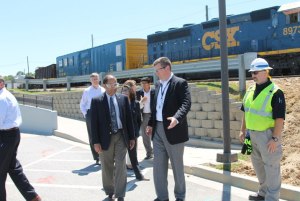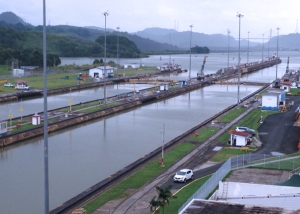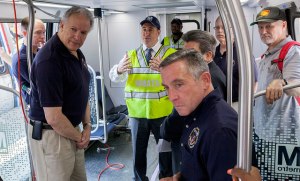By Christopher Hart
 It is said that safety is not a destination but a never-ending journey.
It is said that safety is not a destination but a never-ending journey.
At the NTSB, we investigate accidents, make recommendations to prevent recurrences, and work for the adoption of our recommendations. The vast majority of flights take off and land safely, the vast majority of passenger and freight trains make it to their destinations without incident, and the vast majority of pipeline operations successfully move energy and other products into American homes and businesses. When anything goes wrong in any of those transportation processes, we at the NTSB are called upon to investigate and find out what went wrong and why.
All of these transportation operations are part of an enormous and complex web of systems integrated within themselves, and with each other. Together they make up America’s transportation network. And behind the scenes, there are dedicated professionals working each day to take countermeasures against even the possibility of an accident.
I recently had the opportunity to visit four transportation organizations in Atlanta: the Metropolitan Atlanta Rapid Transit Authority (MARTA), CSX, Colonial Pipeline, and Delta Air Lines. It was enormously gratifying to see in some of their safety measures the echoes of past NTSB recommendations – but it was even more gratifying to see proactive safety principles at work, so that the NTSB will hopefully have fewer accidents to investigate in the future. Although different in what and who they transport, MARTA, CSX, Colonial Pipeline and Delta Airlines are similar in their commitment to continuously improving safety.
MARTA provides transportation for approximately 500,000 passengers each weekday using more than 338 rail cars in 38 stations on 48.1 miles of rail. This requires proper rail inspections, rigorous training and detailed-oriented work with a safety-first objective.
It also requires policies that keep up with the times. For example, MARTA’s answer to today’s temptation of operator distraction by personal electronic devices is a zero-tolerance rule among its operators. And Marta means business: a leading cause for termination of MARTA’s operators is operator distraction.
CSX travels different rails and moves more products than people, resulting in different, but equally important, safety concerns. CSX serves 23 states, the District of Columbia and two Canadian provinces. Its network connects major metropolitan centers in the eastern United States, and connects approximately 240 short line and regional railroads and more than 70 ocean, river, and lake ports to population centers of various sizes.
According to CSX officials, last year was CSX’s safest year ever. I visited the CSX REDI Center, where the railroad teaches workers to incorporate the highest level of safety in their daily routines. I was able to witness first-hand the medical screenings available to CSX employees through its wellness program, and I was fascinated to hear how CSX is looking to commercial aviation to make operations even safer.
The company’s new operations rulebook, for example, is based on the aviation rulebook, adapted to rail operations. Kudos to CSX for reaching out to aviation to learn about ways that have worked for others to mitigate safety risk.
Colonial Pipeline Company provides services in an often-overlooked area of transportation – the use of pipelines to transport refined petroleum products to homes and businesses. Colonial moves an average of 100 million gallons of fuel daily through its pipelines. The visit showed me some of they ways that they put safety first.
Colonial knows that its own employees are not the only ones who must be ready to respond if a mishap occurs, and they showed me the emergency preparedness training that they provide for communities through which their pipelines travel, as well as their process safety approach, and their industry learning program; each has an aspect touching on pipeline safety external to Colonial itself.
But I also saw a control room where Colonial’s workers monitor its pipelines’ functions all around the country. Because human fatigue is a constant concern for Colonial, employees have ready access to exercise equipment located near the control room and on-site sleep rooms. They even encourages employees’ families to engage in its fatigue training programs, so that spouses understand the importance of proper rest during the employees’ off-duty hours.
Last but not least, I visited Delta Air Lines. In the early days of air travel, aviation was largely for the well-to-do. Today, air travel is mass transportation, carrying more than 730 million passengers annually in the U.S. alone. Nevertheless, airlines like Delta are in an unprecedented period of safety; a U.S. commercial air carrier has not had a fatal accident for more than five-and-a-half years.
As such, Delta was an excellent place to witness the vigilance and systemic thinking that keep this safety record strong. I learned about some of their safety information programs that enable line employees throughout the company to provide feedback regarding Delta’s safety mission. These voluntary reporting programs, along with similar programs in other airlines, have contributed to the industry’s excellent safety record.
A key aspect of these safety programs is that they are non-punitive. Non-punitive feedback is vital to catching small problems before they become big problems. Delta maintains a safety management system, and aggressively uses information from the voluntary reporting programs to inform the safety management process and help them find possible safety issues.
What have I learned from my visits to these transportation giants? I was pleased to see how important safety is to all of them, whether they carry people, products, or fuel, and whether their transportation is by rail, pipeline, or air. But more than that, I was able to see first-hand the daily hard work that helps ensure the high level of safety evident in the transportation of people and goods throughout America.
The NTSB often adds emphasis to the need for safety initiatives within both government and industry when we find lapses in the course of our accident investigations. The NTSB’s ability to find and report on any such safety lapses is part of what helps to keep America’s safety record moving steadily forward.
It was truly a pleasure to meet so many people who cared so much about safety and whose safety decisions and processes are behind the scenes each time we take a seat on an airplane or train, see a freight train rolling by, or use the energy transported by pipelines. One of America’s great achievements has been the creation of a transportation network in which safety is the rule, and accidents – such as those the NTSB investigates – are thankfully the exception.







